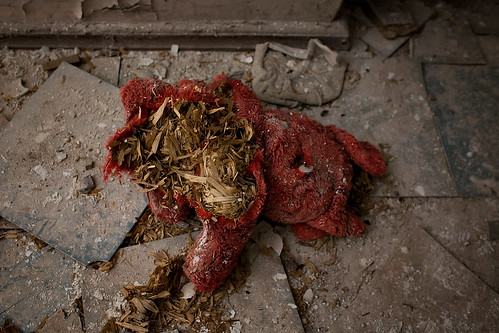Where to go in Belarus
Places I saw and recommend in Belarus: Minsk, Brest, and the Chernobyl Exclusion Zone.
Entering the Chernobyl Exclusion Zone

My Belarusian friends knew that I wanted to inhale radioactive air. Therefore, the next day Mikhail, Dimitri’s father, offered to drive Irina and me into the Chernobyl Exclusion Zone. Although the Chernobyl reactor was in Ukraine, it was just 16 kilometers (10 miles) from the Belarus border. Since most of the radioactive plume blew onto Belarus, most of the contaminated Zone is in Belarus. The military was guarding all the entrances. Nobody could enter unless you had family ties in the zone. In 2004, it was illegal for any foreigner to enter the zone (Ukraine opened their side of the zone to tourists in 2011). Therefore, Mikhail was taking a big risk in trying to sneak me in.
As we approached the checkpoint, Mikhail told me not to open my mouth. He will tell the guard that we’re visiting relatives. Since he lives just 40 kilometers from the zone, it’s a believable story. The guard examined Mikhail’s documents. Then he looked at me. I stopped breathing.
The guard barked out a question in Russian. I had no clue what he was asking. My lips began to part, as I thought about something to say in Russian.
Just in time, Mikhail answered the question. The guard relaxed, raised the gate, and waved us through. I exhaled and took a deep breath of radioactive air. We were entering what was the most radioactively and chemically contaminated area in the world.
 What’s strange is that the zone didn’t look so bad: it looked more like a ghost town than a wasteland. I expected a gray, desolate, and lifeless area. Instead, plants flourish everywhere. Abandoned buildings have trees and vines growing out of broken windows. Everywhere we drove, the streets were empty, but nature had taken over. Rusted heaps of metal lay off the road, as if they were quickly abandoned. All the man-made elements of the zone were dying, but life was springing forth in every corner. It was green everywhere you looked on that August day. The zone was a glimpse of what would happen if humans suddenly vanished from the earth.
What’s strange is that the zone didn’t look so bad: it looked more like a ghost town than a wasteland. I expected a gray, desolate, and lifeless area. Instead, plants flourish everywhere. Abandoned buildings have trees and vines growing out of broken windows. Everywhere we drove, the streets were empty, but nature had taken over. Rusted heaps of metal lay off the road, as if they were quickly abandoned. All the man-made elements of the zone were dying, but life was springing forth in every corner. It was green everywhere you looked on that August day. The zone was a glimpse of what would happen if humans suddenly vanished from the earth.
We parked at the dilapidated house of Mikhail’s father. The wooden structure was decaying; moss grew in the dark, wet places. Dust-covered tools and random objects lay on the floor, forgotten. There was a small farm in the back. Entropy ruled: you could see the remnants of an organized vegetable plot, but it was fading fast. Mikhail told me that scientists discovered mutated plants in the zone. Still, apple trees were bearing things that looked like fruit. I plucked an apple and examined it. It looked normal. I bit into it. Radioactivity never tasted so good! Finnish authorities warn against eating mushrooms and fish around Chernobyl because their levels of radioactive cesium-137 still exceeds the EU standards. Hey, they didn’t mention apples, so I ate the whole thing! Who needs GMO apples when you can have yummy radioactive ones?
It’s hard to believe, but a few loonies live permanently in the zone. We drove by two babushkas sitting outside their shacks. It’s hard to imagine how these grandmothers live here. They have no electricity, police, stores, or government services. These Chernobyl survivors cling to their homes, because that is all they have. Probably only a few dozen live in the zone, but two million Belarusians still live in the hardest hit areas. They don’t move because the state-controlled labor market is rigid. The government employs most people and helps with housing. If you move, good luck finding a job and a house. Besides, who are you going to sell your radioactive house to?
Mikhail said the government relocated 75,000 people “just for show.” They were probably the folks who were glowing in the dark. Most had to stay put. The government didn’t want to relocate two million people and abandon the vital industries in the southeast. In fact, just three months after the accident, the Soviets forced the surviving Chernobyl plant workers to return to their offices, which were located just a five-minute walk from the blown up reactor. They had to restart the remaining three reactors to make sure that people had power during the winter. Many Chernobyl workers died from prolonged radiation poisoning. Today, the government downplays the dangers of living in these areas. They are encouraging resettlement and are cutting benefits to those who suffered from the accident.
This is an excerpt from The Hidden Europe: What Eastern Europeans Can Teach Us. You should also listen to the WanderLearn Podcast episode on Belarus.
Recommended reading
Read up about Belarus in Wikipedia and the CIA Factbook.
Travel deals to Belarus
Check my favorite travel sites:



